Pensamiento Positivo y Realidad //Positive Thinking and Reality
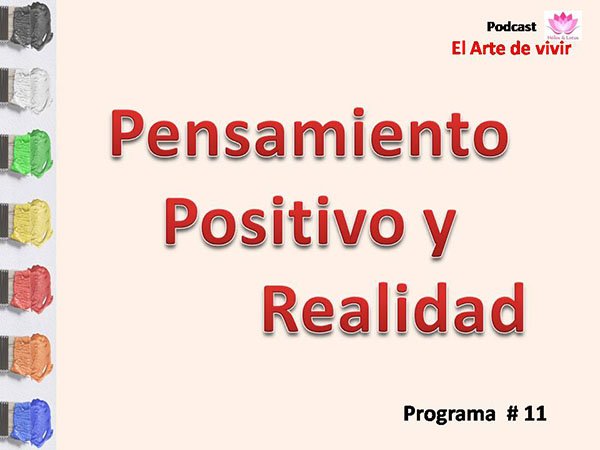
El pensamiento positivo por la cantidad de enfoques y corrientes que han surgido en las últimas décadas genera polémicas sobre todo cuando lo contrastamos con la realidad, es allí donde brotan las preguntas que nos llevan a cuestionarlo: ¿Es posible mantener un pensamiento positivo cuando la realidad es adversa?; ¿puede el pensamiento positivo transformar mi realidad?; ¿Puedo transformar mi pensamiento negativo hacia otros más positivos?, ¿Sirve de algo esta transformación? Estos cuestionamientos son válidos y como toda propuesta encuentra sus defensores y detractores.
Pensamiento positivo y realidad fue el tema que abordamos anoche 22 de junio en el podcast “El Arte de Vivir”. Un tema que surge para la discusión a raíz de un planteamiento que nos hacía @slwzl en el podcast anterior al señalar que: “demasiado pensamiento positivo tampoco es bueno, a veces toca mirar realidades”, idea en que los presentes estuvimos de acuerdo y a su vez nos llevó a plantearnos profundizar en el tema, Así que hoy les traigo un resumen de esta interesante y productiva tertulia que @miriannalis, el grupo de amigo que nos acompañó y mi persona fuimos desarrollando bajo la perspectiva que nos mueve: expandir nuestro ser y desarrollar nuestras competencias y habilidades para vivir en el mayor bienestar posible.

Iniciamos la actividad con dos versos de la canción “Volar” de El Kanka, pieza que no conocía y que la amiga @charjaim me la obsequió en el juego de los amigos secretos, que en su mes aniversario, propuso nuestra comunidad @holos-lotus. La traigo a colación porque su mensaje nos lleva a la idea de la felicidad y nos sugiere dos estrategias que el pensamiento positivo promueve como vía para alcanzarla: soltar y dejar pasar. Pero, ¿De qué se trata el pensamiento positivo?
Se trata de procurarnos de manera intencionada, consciente, deliberada lo que nosotros consideramos la felicidad, es decir queremos ser felices. ¿Es un pensamiento nuevo? No, son incontables los pensadores, filósofos, científicos, hombres y mujeres comunes que nos hemos hecho las preguntas ¿Qué es la felicidad y cómo la obtenemos? Ahora bien, para llegar al cómo es conveniente saber el qué, conocer lo que quieres, lo que buscas.
Desde las diversas escuelas occidentales y orientales, mucho antes de nuestra era y posterior a ella filósofos y estudiosos de la edad media, la modernidad y los contemporáneos han dado respuesta a lo que consideran la felicidad y como lograrla. Sin riesgo a equivocarme me parece que todos coinciden que el ser feliz esta en cada quien, es decir es tu responsabilidad.
Una de las corrientes que le ha dado fuerza al pensamiento positivo ha sido la psicología positiva presentada al mundo en 1999 por el psicólogo Martín Seligman cuando señaló que la psicología estaba en deuda con las personas porque hasta ese momento se ha enfocado en el estudio de los aspectos negativos de la mente y el comportamiento humano obviando aquellos aspectos positivos que conducen al bienestar y la felicidad. La psicología positiva marco un precedente dándole validez científica a los estudios y experimentos relacionados con esta rama de la psicología. 1
Seligman señala en el desarrollo de su teoría que la felicidad, el bienestar o una vida plena como él la llama, está conformado por tres factores:
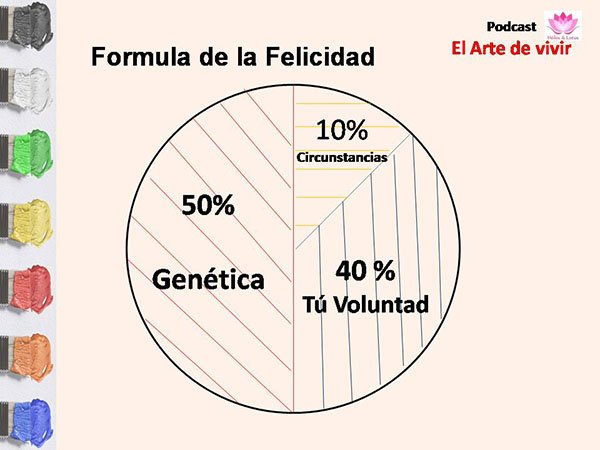 Fuente
Fuente50% está conformado por los rasgos genéticos, nuestra disposición innata para ser felices.
10% corresponde a las circunstancias que nos rodean y
40 % lo que cada uno hace para ser feliz y que él lo llama la voluntad.
Lo cual no significa que sean unos porcentajes estáticos porque tal vez de ese 50% genético tú tienes un 25% que suma hacia el lado positivo, es decir no eres tan catastrófico o, que de pronto todas las circunstancias que te rodean no son tan desfavorables sumando con ello puntos a tu favor.
Otro aspecto relevante que nos platea la teoría de Seligman son los pilares básicos que sustentan la psicología positiva estos son:
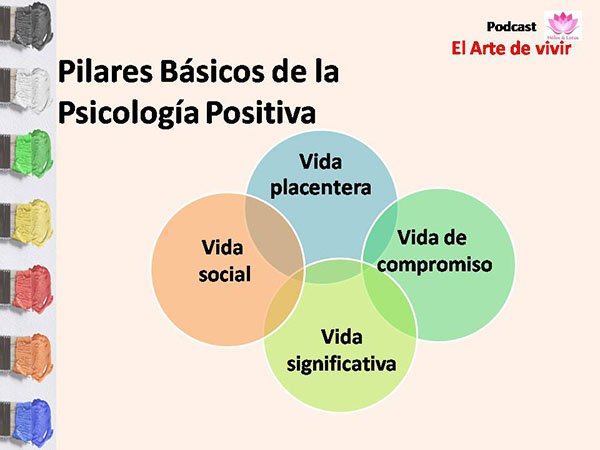
La vida placentera. Que se encuentra relacionada con las emociones positivas y que cada uno puede desarrollar las habilidades necesarias para procurarse bienestar.
Vida de compromiso. Que tiene que ver con nuestro hacer y las responsabilidades que asumimos a lo largo de la vida. Quizás la clave de este pilar se encuentra, relacionándolo con el tema pasado, en como vemos nuestras responsabilidades: como una carga o como una fuente de alegría, satisfacción y logro.
Vida significativa: Relacionada con el sentido de la vida, sentirnos parte del colectivo humano y trascender, ir más allá de nosotros, dando y ayudando a otros a desarrollar sus propias potencialidades.
La vida social (2009). Que comprende los vínculos positivos, entendiendo por estos los lazos afectivos-sociales que vamos construyendo en el transcurso de la vida. Sentir que amamos, respetamos, que somos solidarios, empáticos y que recibimos afecto de los demás nos hace ser más felices. Para ampliar el tema te recomiendo este artículo.
Lo cierto es que aun cuando la genética y las circunstancias, aspectos que podemos enmarcar en nuestras realidades particulares y colectivas, no estén a nuestro favor, siempre tendremos un 40% donde podemos actuar para procurarnos ese camino que llamamos felicidad y el cual la psicología positiva insiste en que su fuente esta en el desarrollo de nuestras fortalezas y habilidades personales para vivir sintiéndonos que llevamos una vida plena.
@irvinc fue nuestro invitado a la mini entrevista y comenzó haciendo una breve distinción entre el pensamiento positivista y el pensamiento positivo, acotando que el primero corresponde a una doctrina científico-filosófica que explica la realidad que interpreta el conocimiento desde lo que es verificable en la experiencia y que el pensamiento positivo atiende más a una conducta actitudinal de la persona a ver la vida y su entorno de una manera más amable y con mayor aceptación de aquello que no podemos cambiar.

También hizo hincapié en que el pensamiento por sí solo no transforma la realidad pero si este va unido a la actitud y la acción podemos tener respuestas más favorables de nuestro entorno, destacando que desde la mirada que tengamos la situaciones que vivimos, los hechos que nos suceden nos impactaran de manera distinta, según sea esta.
@miriannalis puntualizó que los pensamientos negativos pueden ser muy variados entre ellos tenemos: los juicios, las críticas, la magnificación de los hechos y las sobre generalizaciones. Estos pensamientos se producen, generalmente, en el subconsciente y socaban nuestro bienestar, lo que la llevó a preguntarnos ¿Para qué sirve una actitud positiva? Las respuestas nos se hicieron esperar y como una lluvia de ideas, estas fueron cayendo:
Para tener buena salud mental, paz, vitalidad, fortaleza para enfrentar los obstáculos, nos vemos más atractivos, tranquilidad, el cerebro funciona mejor, el día y los quehaceres se hacen más livianos, energía, vitalidad, nos hacen más empáticos, regula el estrés… Si somos conscientes de todos estos beneficios y que el pensamiento positivo corresponde más a una actitud, una elección personal es apropiado preguntarse: ¿Cómo cultivar pensamientos positivos? Para lo cual nos presentó el siguiente material:
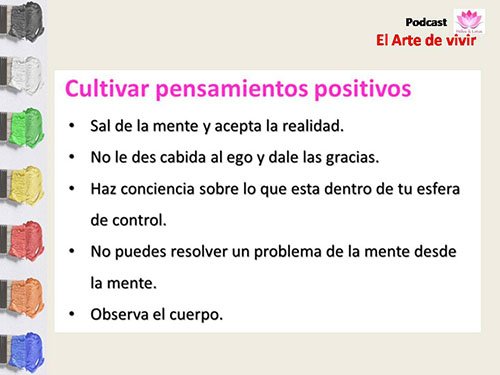
Tenemos que buscar un momento un espacio para salir de la mente, los problemas de la mente no se resuelven desde la mente, tengo que empezar a usar otras estrategias para hacer ese corte y el cambio de pensamiento. Cuando estoy en el pensamiento negativo generalmente lo que estoy es negando esa realidad que estoy viviendo, eso que estoy experimentando.
Si es una elección personal y nos situamos ante esa realidad desde una visión más sana, comenzamos a darnos cuenta que no le vamos a dar cabida al ego pero si voy a reconocer ese esfuerzo que está haciendo y le voy a dar las gracias. Por ejemplo, si es un pensamiento preocupante, ¿Cómo le agradezco yo eso al ego? Le voy a decir: Gracias preocupación, por venir a mí y mostrarme que debo andar con cuidado y te despides de ese pensamiento dándole un nuevo enfoque, vas a resignificar a cambiar el significado.
Es importante que vayamos afinando ese papel de observador. En ese punto es darnos cuenta de que es lo que está pasando por mi mente, darnos cuenta hacia donde se inclina el pensamiento, el ego, en un determinado momento. Tomando en cuenta que es una decisión personal entonces me voy a ocupar, Por ejemplo: si mi preocupación es que el niño corre peligro porque estamos en un lugar donde se puede caer, entonces yo no me voy a ocupar en que él no se vaya a caer sino en que cosas puedo yo mejorar en ese espacio para evitar la caía o para hacerle más seguro el espacio. Se trata de resignificar las situaciones, en buscar otra óptica.
Al aceptar la realidad pasa a observar lo que está en tu esfera de control. Si en una situación que causa molestia, incomodidad me pongo a alimentarla con pensamientos negativos sobre las personas, el mundo, el tiempo que pierdo… a donde quiero llegar, ¿al tope del malestar? por supuesto, que no es conveniente comenzar a decirme lo bueno que la situación que de entrada es negativa, es decir, no vamos a jugar al autoengaño, pero si plantearnos qué oportunidades tengo en ese momento.

Si yo resignifico y puedo mirar las cosas de una manera diferente y me doy cuenta que esa determinada situación escapa de mi esfera de control, lo oportuno es aceptar que estoy allí y aceptar la situación con la mejor actitud posible y hacerlo por mí, por mi salud, por mi bienestar.
Cuando hablamos de trabajar fuera de la mente es porque el cuerpo juega un papel fundamental. La mente siempre en cualquier estado en que se encuentre: positivo o negativo produce sensaciones en el cuerpo. Si mis pensamientos son positivos me siento que ando más libre, liviano, fluido, si estoy en constante tensión, preocupación, en estado de alarma mi cuerpo lo va a sentir en algún momento.
Después del primer paso: observar mi pensamiento, me voy a ir a observar mi cuerpo: ¿Qué está pasando en mi cuerpo? si comienzo a sentir dolor en el cuello, dolores de cabeza, se me duermen las manos, tengo mal humor… cualquier situación que comience a transitar por tu cuerpo también te está haciendo un llamado de atención hacia tu mente y emoción que tienes que reconocer y trabajar.
Entonces es una cuestión de actitud es como decía @emiliorios es el pensamiento de lo posible, no se trata de ese positivismo vacío, de engañarnos pero, si de darle otra vuelta al asunto, buscar otro enfoque que nos lleve a tener una vida más sana y en mayor bienestar.
Cuando hablamos de pensamiento positivo hablamos de un todo, de la integralidad que somos: pensamiento, actitud, enfoque, acción en la conjugación de todos estos elementos encontramos una manera de vivir, creamos nuestro propio arte de vivir y solo cada uno decide que colores y ritmos le coloca. Los estudios, las experiencias apuntan que el pensamiento positivo no es ignorar situaciones que nos son adversas sino afrontarlas desde una óptica más optimista, positiva que nos conduzca a una vida más feliz, así que trabajemos en ello.
En esta oportunidad el tema se volvió tan extenso que no recogí las oportunas participaciones de los amigos, me disculpan esta. Gracias por ser y estar, por esas participaciones que nutren los temas propuestos y nos ayudan a ser cada día mejores personas con nosotros mismos y los demás.

In English
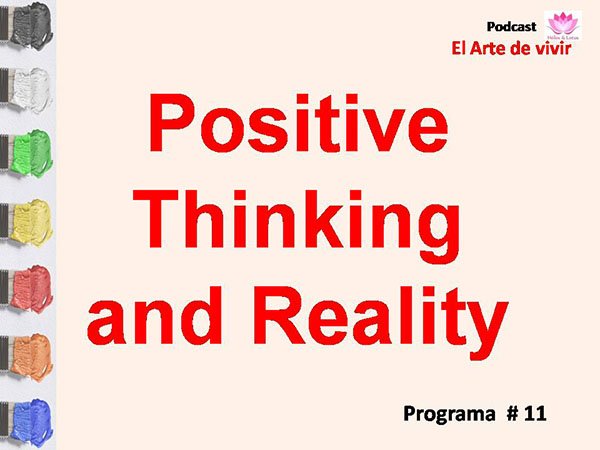
Positive thinking, due to the number of approaches and currents that have emerged in recent decades, generates controversy, especially when we contrast it with reality. It is there where the questions that lead us to question it arise: Is it possible to maintain positive thinking when reality is adverse; can positive thinking transform my reality; can I transform my negative thinking into more positive ones; is this transformation of any use? These questions are valid and, like all proposals, they have their defenders and detractors.
Positive thinking and reality was the topic we addressed last night June 22 in the podcast "The Art of Living". A topic that arose for discussion as a result of an approach made by @slwzl in the previous podcast when he pointed out that: "too much positive thinking is not good either, sometimes you have to look at realities", an idea in which those present agreed and in turn led us to consider delving deeper into the subject. So today I bring you a summary of this interesting and productive discussion that @miriannalis, the group of friends who accompanied us and myself were developing under the perspective that moves us: to expand our being and develop our skills and abilities to live in the greatest possible welfare.

We started the activity with two verses of the song "Volar" by El Kanka, a piece that I did not know and that the friend @charjaim gave it to me in the game of secret friends that our community @holos-lotus proposed in its anniversary month. I bring it up because its message leads us to the idea of happiness and suggests us two strategies that positive thinking promotes as a way to achieve it: letting go and letting go. But what is positive thinking all about?
It is about intentionally, consciously and deliberately procuring for ourselves what we consider happiness, i.e. we want to be happy. Is it a new thought? No, there are countless thinkers, philosophers, scientists, ordinary men and women who have asked the questions: What is happiness and how do we obtain it? Now, to get to the how it is convenient to know the what, to know what you want, what you are looking for.
From the various Western and Eastern schools, long before our era and after it, philosophers and scholars of the Middle Ages, modernity and contemporaries have given answers to what they consider happiness and how to achieve it. Without risk of being wrong, it seems to me that they all agree that being happy is in each person, that is to say, it is your responsibility.
One of the currents that has given strength to positive thinking has been the positive psychology presented to the world in 1999 by psychologist Martin Seligman when he pointed out that psychology was indebted to people because until that moment it has focused on the study of the negative aspects of the mind and human behavior obviating those positive aspects that lead to well-being and happiness. Positive psychology set a precedent by giving scientific validity to the studies and experiments related to this branch of psychology.
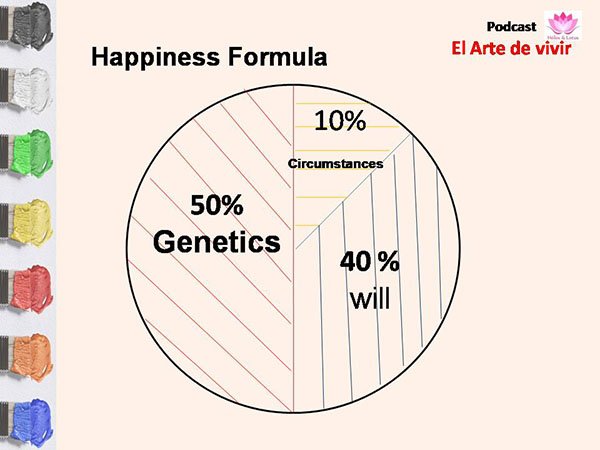 source
sourceSeligman points out in the development of his theory that happiness, well-being or a full life as he calls it, is made up of three factors:
50% is shaped by genetic traits, our innate disposition to be happy.
10% corresponds to the circumstances that surround us, and
40% corresponds to what each of us does to be happy, which he calls the will.
This does not mean that they are static percentages because perhaps of that genetic 50% you have a 25% that adds up to the positive side, that is to say that you are not so catastrophic or, that suddenly all the circumstances that surround you are not so unfavorable adding with it points in your favor.
Another relevant aspect that Seligman's theory presents to us are the basic pillars that support positive psychology, these are:
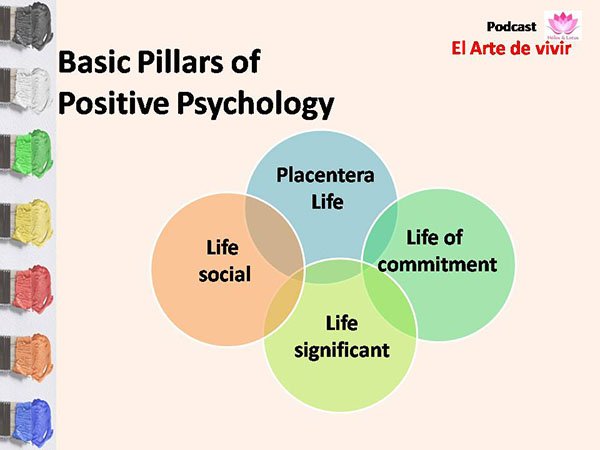
The pleasant life. Which is related to positive emotions and that everyone can develop the necessary skills to procure well-being.
Life of commitment. This has to do with our actions and the responsibilities we assume throughout our lives. Perhaps the key to this pillar is found, in relation to the past theme, in how we see our responsibilities: as a burden or as a source of joy, satisfaction and achievement.
Meaningful life. Related to the meaning of life, feeling part of the human collective and transcending, going beyond ourselves, giving and helping others to develop their own potential.
Social life (2009). This includes positive bonds, which are understood as the affective-social ties that we build during the course of our lives. Feeling that we love, respect, that we are supportive, empathetic and that we receive affection from others makes us happier. To expand on this topic, I recommend this article
The truth is that even when genetics and circumstances, aspects that we can frame in our particular and collective realities, are not in our favor, we will always have 40% where we can act to procure that path we call happiness and which positive psychology insists that its source is in the development of our strengths and personal skills to live feeling that we lead a full life.
@irvinc was our guest at the mini-interview and began by making a brief distinction between positivist thinking and positive thinking, noting that the first corresponds to a scientific-philosophical doctrine that explains the reality that interprets knowledge from what is verifiable in experience and that positive thinking is more an attitudinal behavior of the person to see life and their environment in a kinder way and with greater acceptance of what we can not change.

He also emphasized that thinking alone does not transform reality, but if it goes together with attitude and action we can have more favorable responses from our environment, stressing that from the look we have the situations we live, the events that happen to us will impact us differently, depending on this.
@miriannalis pointed out that negative thoughts can be very varied, among them we have: judgments, criticisms, magnification of facts and over generalizations. These thoughts are generally produced in the subconscious and undermine our well-being, which led her to ask us what is a positive attitude for? The answers were not long in coming, and like a brainstorm, they came pouring out:
To have good mental health, peace, vitality, strength to face obstacles, we look more attractive, tranquility, the brain works better, the day and chores become lighter, energy, vitality, make us more empathetic, regulates stress ... If we are aware of all these benefits and that positive thinking corresponds more to an attitude, a personal choice is appropriate to ask: How to cultivate positive thoughts? For which he presented us with the following material:

We have to look for a moment a space to get out of the mind, the problems of the mind are not solved from the mind, I have to start using other strategies to make that cut and change of thinking. When I am in negative thinking generally what I am doing is denying that reality that I am living, that I am experiencing.
If it is a personal choice and we face that reality from a healthier point of view, we begin to realize that we are not going to give space to the ego but we are going to recognize the effort it is making and we are going to thank it. For example, if it is a worrying thought, how do I thank the ego for that? I will say: Thank you worry, for coming to me and showing me that I must be careful and you say goodbye to that thought giving it a new focus, you will re-signify and change the meaning.
It is important that we refine this role of observer. At that point it is to realize what is going through my mind, to realize where the thought, the ego, is leaning at a given moment. For example: if my concern is that the child is in danger because we are in a place where he can fall, then I am not going to worry about him not falling, but about what things I can improve in that space to prevent him from falling or to make the space safer. It is about re-signifying situations, looking for a different perspective.
By accepting reality, you can observe what is in your sphere of control. If in a situation that causes discomfort, discomfort I start to feed it with negative thoughts about people, the world, the time I waste... where do I want to get to, to the top of the discomfort? Of course, it is not convenient to start telling me the good that the situation is negative from the beginning, that is, we will not play at self-deception, but we should ask ourselves what opportunities I have at that moment.

If I re-signify and can look at things in a different way and realize that this situation is beyond my sphere of control, the best thing to do is to accept that I am there and accept the situation with the best possible attitude and do it for myself, for my health, for my wellbeing.
When we talk about working outside the mind it is because the body plays a fundamental role. The mind always in whatever state it is in: positive or negative produces sensations in the body. If my thoughts are positive I feel that I walk more free, light, fluid, if I am in constant tension, worry, in a state of alarm my body will feel it at some point.
After the first step: observing my thoughts, I am going to observe my body: what is happening in my body? if I start to feel pain in my neck, headaches, my hands fall asleep, I have a bad mood... any situation that starts to go through your body is also making a call to your mind and emotion that you have to recognize and work on.
So it is a matter of attitude is as @emiliorios said is the thought of the possible, it is not about that empty positivism, to deceive us but, if to give another turn to the matter, look for another approach that leads us to have a healthier life and greater welfare.
When we speak of positive thinking we speak of a whole, of the integrality that we are: thought, attitude, approach, action in the conjugation of all these elements we find a way of living, we create our own art of living and only each one decides what colors and rhythms to place on it. Studies and experiences point out that positive thinking is not to ignore adverse situations but to face them from a more optimistic and positive point of view that leads us to a happier life, so let's work on it.
In this opportunity the topic became so extensive that I did not collect the opportune participations of the friends, excuse me for this one. Thank you for being and being, for those participations that nurture the proposed topics and help us to be better people every day with ourselves and others.

Translated with www.DeepL.com/Translator (free version)
Fuente de imágenes: Archivo personal elaboradas en Power Point
Fuente de frases: 1 - 2y3


https://twitter.com/damaryspacheco5/status/1540129793366261760
The rewards earned on this comment will go directly to the people sharing the post on Twitter as long as they are registered with @poshtoken. Sign up at https://hiveposh.com.
Esta es una de las actividades que más he disfrutado.
He aprendido mucho, me hizo pensar bastante; porque hay mucha discrepancia aún entre lo que es ser positivo y lo que es ser exaltado, el tener exaltación anímica fuera de la realidad.
Creo que todo lo expuesto nos condujo a poner los pies sobre la tierra, pero siempre teniendo en cuenta que las cosas es posible lucharlas y hacerlas crecer.
Muchísimas gracias por la mención y por siempre estar pendiente de nuestro crecimiento.
Gracias @emiliorios por acompañarnos en esta actividad de crecimiento donde todos vamos aprendiendo. Poner los pues en el suelo como dices es necesario, sin embargo, soñar, desear, proponerse en lo que nos mueve.😊 Saludos
Gracias, por estar siempre presente.
Una vez más el debate fue interesante. Las posturas de los participantes siempre llaman poderosamente la atención, he aprendido con ustedes a mirar desde diferentes perspectivas y entender realidades complejas a las cuales somos sometidos día a día. Saludos cordiales para el maravilloso equipo.
Excelente tema, me encantó que hubiesen usado esas frases de esa canción que me gusta tanto.
Vivir entre el optimismo y el pesimismo y mantener la mejor actitud siempre: mucha tela que cortar con este tema.
Saludos cordiales
Es un gran trabajo el que haces recogiendo todo lo que conversamos en nuestras tertulias que sirve para compartir con los que no pudieron asistir. Me encantó el programa y cada uno de los aportes que surgieron, aprendí gracias a ti más de la psicología positiva 😊
Gracias por este aporte 🙏
@tipu curate 4
Upvoted 👌 (Mana: 0/55) Liquid rewards.
Hola mi estimada @damarysvibra el pensamiento es un factor de suma importancia, vital podría decirse. Para mí todo inicia con en el pensamiento y en la forma en la cual accionas sobre tu propia vida. En pensamiento y la acción deben estar siempre unidos sólo así se pueden hacer realidad nuestros sueños y metas. Un abrazo excelente post
Un artículo muy bueno. Si creo que nuestros pensamientos influyen en la forma en la cual se hacen realidad o no todo lo que nos proponemos.
Me gusto mucho leerte!!! Totalmente de acuerdo contigo!!! Gracias por compartir!!!
Este tema me ayudó mucho a reflexionar. Saludos y abrazos a todos. Realicé una publicación para dar un aporte al debate.
https://hive.blog/hive-131951/@lilianajimenez/pensamiento-positivo-y-realidad-uniendome-al-debate
¡Guao que sesión tan positiva! ¡Cuán valiosos aportes @damarysvibra, @slwzl, @Charjaim, @irvinc, @miriannalis! ¡Enriquecimiento total!

Muchas gracias por compartir el contenido del encuentro, @damarysvibra, ya que permite nutrirse a la distancia y a la distancia en tiempo también.
Me quedé con este cuadro para cultivar pensamientos positivos, excelente canalizador para seguir la ruta en positivo (no con positivismo):
También me quedé con el fragmento que citas de El Kanka (Volar): "Solté las riendas y dejé pasar", algo que vengo practicando desde hace muy poco tiempo en mi vida.
Gracias, gracias, gracias.